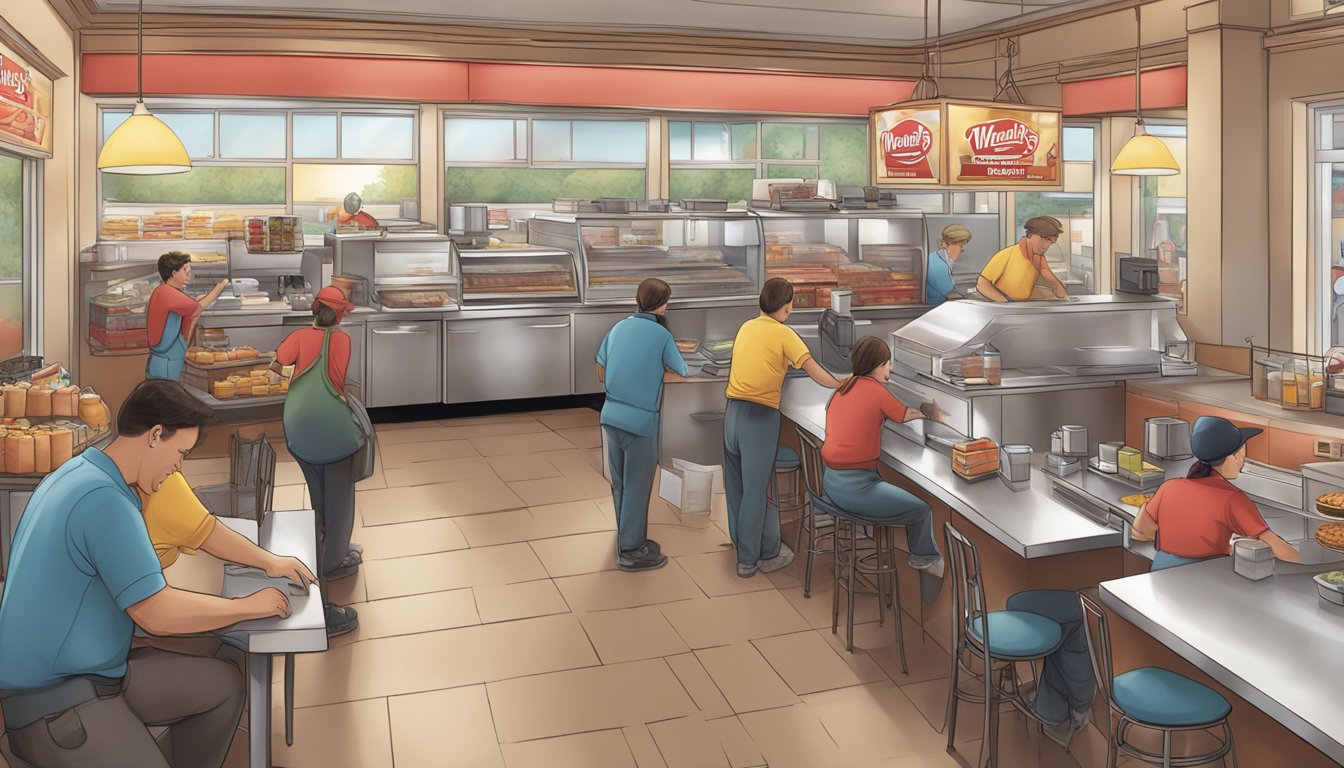Wendy’s entry into the breakfast market in early 2020 marked a significant shift in the fast-food industry landscape. Despite being a latecomer to the morning meal segment, the company quickly established itself as a formidable competitor. Wendy’s innovative approach and strategic execution propelled it to become the second-largest breakfast fast food brand, challenging long-established players like Burger King.
The timing of Wendy’s breakfast launch, just before the COVID-19 pandemic, presented unique challenges and opportunities. While lockdowns disrupted traditional breakfast routines, Wendy’s adapted its strategy to capitalize on changing consumer behaviors. The company leveraged digital platforms and targeted marketing campaigns to generate buzz and attract customers during uncertain times.
Wendy’s success in the breakfast segment demonstrates the power of a well-executed business strategy. By learning from past mistakes and focusing on menu innovation, the company has carved out a significant market share in a highly competitive space. This late entry strategy has not only boosted Wendy’s overall sales but also positioned the brand for continued growth in the morning daypart.
Wendy’s Strategic Positioning in the Fast Food Industry

Wendy’s has carved out a unique position in the competitive fast food landscape through strategic differentiation and leveraging its brand heritage. The company focuses on quality, freshness, and innovation to stand out from rivals.
Assessing the Competitive Landscape
Wendy’s operates in a highly saturated market dominated by giants like McDonald’s and Burger King. To compete effectively, Wendy’s emphasizes its use of fresh, never frozen beef and made-to-order meals.
The company has also embraced digital innovation, investing in mobile ordering and delivery partnerships to meet changing consumer preferences. This tech-forward approach helps Wendy’s attract younger customers and stay relevant in a rapidly evolving industry.
Wendy’s menu diversification strategy includes offering premium items alongside value options, allowing it to target various consumer segments.
Leveraging Brand Heritage for Differentiation
Wendy’s capitalizes on its long-standing reputation for quality and authenticity. The brand’s founder, Dave Thomas, remains a key part of Wendy’s identity, symbolizing commitment to fresh ingredients and superior taste.
The company’s square burger patties serve as a visual differentiator, reinforcing its “cut above the rest” positioning. Wendy’s also maintains a playful, witty social media presence that resonates with younger audiences and reinforces brand loyalty.
By emphasizing its roots in quality while adapting to modern trends, Wendy’s maintains a distinct identity in the crowded fast food market. This balance of tradition and innovation helps the brand attract both long-time fans and new customers.
Navigating Market Changes

Wendy’s breakfast launch coincided with significant shifts in consumer behavior and dining preferences. The company adapted its strategy to align with new market realities and evolving customer needs.
Impact of Covid-19 on Consumer Behavior
Covid-19 dramatically altered breakfast routines. With more people working from home, traditional morning commutes disappeared, impacting fast-food breakfast sales. Wendy’s responded by emphasizing pick-up and delivery options.
The company invested $14.6 million in breakfast advertising in 2020, with a focused push around the launch. This timing placed Wendy’s new breakfast menu in the spotlight as consumers sought comfort food during uncertain times.
Digital sales became crucial. Wendy’s enhanced its mobile app and online ordering systems to cater to customers preferring contactless options. This move improved accessibility and convenience for breakfast seekers.
Adapting to Evolving Dining Preferences
Wendy’s recognized changing tastes and adjusted its menu accordingly. The company highlighted popular items like bacon to appeal to indulgent breakfast eaters.
Drive-thru service became a key focus. Wendy’s optimized its drive-thru operations to ensure quick service for time-pressed customers. This strategy helped maintain sales even as dine-in options were limited.
The brand leveraged its strong social media presence to engage customers. Witty marketing campaigns and interactive content kept Wendy’s breakfast offerings top-of-mind for consumers.
Wendy’s also prioritized customer satisfaction. The company gathered feedback and made menu adjustments to ensure its breakfast offerings met consumer expectations and preferences.
Unpacking the Breakfast Business Decision

Wendy’s decision to enter the breakfast market in 2020 was driven by strategic considerations around menu innovation, revenue potential, and competitive positioning. The move aimed to capitalize on a lucrative daypart while differentiating from rivals.
Understanding the Delay in Breakfast Entry
Wendy’s late entry into breakfast allowed the company to learn from competitors’ mistakes and refine its approach. The chain had previously attempted breakfast launches in the 1980s and 2000s but struggled to gain traction. This time, Wendy’s took a more calculated approach.
The company invested heavily in menu development and operational efficiency. It focused on creating unique offerings that aligned with its brand identity. Wendy’s also ensured its breakfast items could be prepared quickly without disrupting other dayparts.
By waiting, Wendy’s avoided the initial breakfast wars and could enter the market with a fresh perspective. This strategy allowed for thorough market research and targeted menu creation.
Breakfast Menu Innovation and Appeal
Wendy’s breakfast menu was designed to stand out in a crowded market. The company leveraged its signature items and flavors to create breakfast versions that resonated with customers.
Key innovations included:
- Breakfast Baconator
- Frosty-ccino
- Honey Butter Chicken Biscuit
These items balanced familiarity with novelty, appealing to both existing Wendy’s fans and new breakfast customers. The menu also included healthier options to cater to diverse preferences.
Wendy’s focused on quality ingredients and made-to-order preparation to differentiate from competitors’ pre-made offerings. This approach aligned with the brand’s fresh, never frozen beef positioning.
Evaluating the Breakfast Revenue Potential
Wendy’s saw breakfast as a significant growth opportunity. The morning daypart represented untapped revenue potential and a chance to increase overall store profitability.
Early results were promising:
- Breakfast sales helped offset pandemic-related declines in other dayparts
- The company reported strong breakfast performance even as competitors struggled
Wendy’s aimed for breakfast to account for 10% of total sales by the end of 2021. This goal underscored the importance of the breakfast segment to the company’s overall growth strategy.
The breakfast expansion also aimed to boost late-night traffic and increase store utilization during traditionally slower hours. This strategy sought to maximize return on existing assets and improve overall operational efficiency.
Operational Considerations for Breakfast Service
Implementing breakfast service requires careful planning around labor and staffing. Wendy’s had to navigate increased costs and personnel needs to successfully launch their morning offerings.
Managing Higher Labor Costs
Adding breakfast service increases labor expenses significantly. Wendy’s needed to schedule additional staff for early morning shifts. This raised overall payroll costs across locations.
The company had to balance these higher expenses against projected breakfast revenue. Careful financial modeling was required to ensure profitability. Wendy’s likely analyzed data on competitor breakfast sales and traffic patterns.
Menu pricing and food costs were also key considerations. Items needed to be priced competitively while maintaining healthy margins. Efficient kitchen processes helped control labor needs.
Staffing and Training Challenges
Recruiting and retaining qualified morning staff presented difficulties. Many workers prefer later shifts, making breakfast slots harder to fill. Wendy’s had to offer competitive wages and benefits to attract talent.
Extensive training was necessary to prepare staff for new breakfast procedures. Employees needed to learn recipes, equipment use, and service standards. This required a significant time investment.
Cross-training existing staff to handle breakfast duties provided more scheduling flexibility. However, it also increased complexity for workers. Clear communication and documentation of processes was essential.
Managers faced challenges in creating fair schedules across breakfast and lunch/dinner shifts. Balancing employee preferences with coverage needs required ongoing effort.
Sales Performance and Growth Metrics

Wendy’s breakfast launch has significantly impacted the company’s overall sales performance. The morning daypart has become a key driver of growth, contributing to same-store sales increases and improved profitability.
Same-Store Sales Growth Analysis
Wendy’s breakfast offering has consistently boosted same-store sales since its introduction. In the fiscal fourth quarter, the breakfast daypart accounted for 5.5% growth in company sales. This momentum continued into the first quarter of 2021, with same-store sales up 6% and projections reaching 10% for the full period.
The breakfast segment now represents 7% of total company sales, demonstrating its growing importance in Wendy’s revenue mix. This performance is particularly noteworthy given the challenges faced by the restaurant industry during this period.
The Role of Discounts and Promotions
Wendy’s has strategically employed discounts and promotions to drive breakfast sales and customer traffic. The company has leveraged value offerings like the Biggie Bag to attract price-conscious consumers. These promotions have helped offset potential traffic declines related to pricing adjustments.
Late-night sales have also played a crucial role in Wendy’s growth strategy. The company reported double-digit sales growth in the late-night daypart, with many restaurants extending their operating hours. This multi-pronged approach of focusing on breakfast, value promotions, and extended hours has allowed Wendy’s to maintain positive same-store sales growth despite challenging market conditions.
Franchisee Relationships and Network Expansion

Wendy’s franchisee model plays a crucial role in its breakfast rollout and international expansion efforts. The company relies heavily on franchisees to implement new strategies and penetrate new markets.
The Franchisee Model and Breakfast Rollout
Wendy’s leveraged its franchisee network to launch its breakfast menu. The company worked closely with franchise owners to ensure a smooth implementation across locations.
Franchisees invested in new equipment and staff training to support the breakfast offerings. This collaboration helped Wendy’s quickly scale its breakfast operations.
The breakfast rollout presented challenges for some franchisees, including increased labor costs and potential cannibalization of lunch sales. Wendy’s addressed these concerns by providing marketing support and operational guidance.
International Expansion and Market Penetration
Wendy’s international expansion strategy relies heavily on franchising. The company partners with local operators to enter new markets and adapt to regional preferences.
Franchisees play a key role in identifying suitable locations and navigating local regulations. This approach allows Wendy’s to expand its global footprint while minimizing direct investment risks.
In some international markets, Wendy’s has modified its breakfast menu to cater to local tastes. Franchisees provide valuable insights into consumer preferences and help tailor offerings accordingly.
The company focuses on strategic market selection for international expansion. It targets regions with growing middle-class populations and increasing demand for quick-service restaurants.
Innovating for the Future

Wendy’s is embracing technological advancements and sustainable practices to stay competitive in the breakfast market. The company is leveraging artificial intelligence and new menu innovations to enhance the customer experience and drive growth.
Technological Advancements in Service
Wendy’s is investing in AI-powered drive-thru systems to reduce wait times and improve order accuracy. These smart systems can recognize repeat customers and suggest personalized menu items based on past preferences.
The company is also developing a mobile app with enhanced features like customizable breakfast combos and exclusive deals. This tech-forward approach aims to attract younger, tech-savvy consumers.
Wendy’s is testing automated kitchen equipment to streamline food preparation. Robotic arms assist with tasks like frying and assembly, increasing efficiency during busy breakfast hours.
Sustainable Growth and Future Prospects
Wendy’s is focusing on sustainable packaging for its breakfast items. The company aims to use 100% recyclable or compostable materials by 2026.
New plant-based protein options are being developed to cater to health-conscious consumers. These items will complement Wendy’s existing high-protein breakfast offerings.
The chain is exploring seasonal menu innovations, including a pumpkin spice-flavored breakfast sandwich for fall. This strategy aims to keep the breakfast menu fresh and exciting.
Wendy’s plans to expand its breakfast hours, potentially offering all-day breakfast at select locations. This move could help capture late-morning and afternoon customers.
Leadership and Company Vision

Wendy’s leadership and vision have been instrumental in shaping its breakfast strategy. CEO Todd Penegor has played a key role in guiding the company’s direction and developing a cohesive brand approach.
CEO Todd Penegor’s Influence
Todd Penegor became Wendy’s CEO in 2016, bringing extensive food industry experience. He recognized the importance of entering the breakfast market to drive growth. Penegor led the development of Wendy’s breakfast menu, ensuring it aligned with the brand’s quality standards. He emphasized the need for differentiation, focusing on fresh-cracked eggs and high-quality ingredients. Penegor’s leadership was crucial in overcoming initial challenges and refining the breakfast offering. His strategic vision helped Wendy’s navigate the competitive landscape and establish a foothold in the morning daypart.
Developing a Cohesive Brand Strategy
Wendy’s brand strategy under Penegor’s leadership has focused on consistency across all dayparts. The company aimed to extend its reputation for quality and freshness into the breakfast segment. This approach included:
- Integrating breakfast items with existing brand elements
- Leveraging digital platforms to promote breakfast offerings
- Expanding the loyalty program to include morning customers
Wendy’s enhanced its mobile app and drive-thru services to cater to breakfast customers. The company also invested in targeted marketing campaigns to build awareness. By aligning breakfast with its overall brand identity, Wendy’s sought to create a seamless experience for customers throughout the day.




